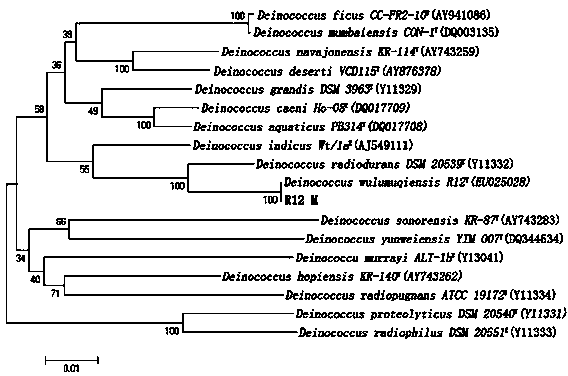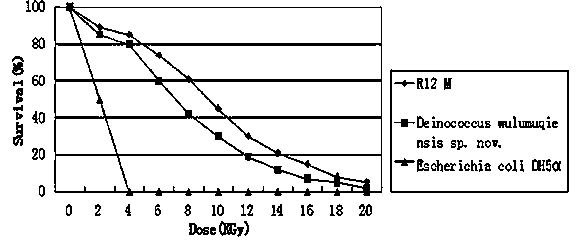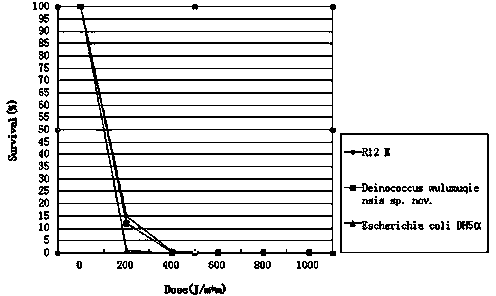Carotenoid high yield strain and application thereof
A technology of carotene and high-yielding strains, applied in the direction of bacteria, microorganisms, biochemical equipment and methods, etc., can solve the problems of high cost and low yield, and achieve the effect of strong radiation resistance and high carotenoid performance
- Summary
- Abstract
- Description
- Claims
- Application Information
AI Technical Summary
Problems solved by technology
Method used
Image
Examples
Embodiment 1
[0021] Embodiment one: bacterial strain Deinococcus wulumuqiensis mutagenesis of sp. nov.
[0022] Inoculate from frozen bacteria stored at -80°C Deinococcus wulumuqiensis sp. nov. (Wang W, Mao J, Zhang Z, Tang Q, Xie Y, Zhu J, Zhang L, Liu Z, Shi Y, Goodfellow M. 2010. Deinococcus wulumuqiensis sp. nov., and Deinococcus xibeiensis sp. nov., isolated from radiation-polluted soil. Int. J. Syst. Evol. Microbiol. 60:2006–2010.) to TGY solid medium, cultured at 30°C for 3-4 days, picked a single colony and inoculated to TGY Liquid medium, cultivated in a 150r / min shaker at 30°C for 3-4 days.
[0023] Measure the absorbance (OD value) of the bacterial solution with a spectrophotometer, and adjust the OD value of the bacterial solution to 1 with physiological saline. Spread the diluted bacterial solution on small iron sheets, 10 μl on each small iron sheet. The small iron sheets coated with the bacterial solution were mutagenized for 0s, 60s, 90s, 120s, 150s, and 180s unde...
Embodiment 2
[0025] Embodiment two: the identification of bacterial strain R12 M
[0026] According to microbiological identification, the strain R12 M belongs to the genus Deinococcus.
[0027] Refer to the "Bergey's Bacteria Identification Manual" and other morphological, physiological and biochemical assays for the R12 M strain. The main physiological and biochemical assay results are shown in Table 1. The strain grows on the surface of TGY solid medium. After 14 days of culture at 30°C, the colony is orange-red, small, round, raised, with neat edges, smooth surface, and opaque; the cells are round and quadruple.
[0028] Table 1 The main physiological and biochemical characteristics of R12 M
[0029]
[0030] Note: In Table 1, "+" means positive reaction; "-" means negative reaction; "ND" means no data; "W" means weak positive reaction.
[0031] The 16S rDNA sequence (SEQ ID NO: 1) of the R12 M strain was obtained by PCR, and sequence determination, BLAST homology comparison and evo...
Embodiment 3
[0032] Embodiment 3: Determination of the radiation resistance of bacterial strain R12 M by gamma rays
[0033] Take the strain R12 M as the test strain, set Deinococcus wulumuqiensis sp. nov. is the positive control, set Escherichia coli DH 5α as a negative control. The three strains were cultured in TGY liquid medium and grown to the logarithmic growth phase, washed with normal saline, centrifuged at 4°C and resuspended with normal saline to obtain a concentration of 1×10 7 -1×10 8 cfu / mL bacterial solution. The three bacterial solutions were divided into 2mL small portions, and exposed to a dose of 0.167kGy / min in an environment of 25°C 60 Under the radioactive source of Co, γ-irradiation treatment was carried out with a gradient of 2.0 kGy in the range of radiation dose from 0 to 20.0 kGy. Every 10 minutes, take 0.1 mL of irradiated bacteria solution, and carry out gradient dilution with physiological saline, and take 100 microliters of each dilution gradient to c...
PUM
 Login to View More
Login to View More Abstract
Description
Claims
Application Information
 Login to View More
Login to View More - R&D
- Intellectual Property
- Life Sciences
- Materials
- Tech Scout
- Unparalleled Data Quality
- Higher Quality Content
- 60% Fewer Hallucinations
Browse by: Latest US Patents, China's latest patents, Technical Efficacy Thesaurus, Application Domain, Technology Topic, Popular Technical Reports.
© 2025 PatSnap. All rights reserved.Legal|Privacy policy|Modern Slavery Act Transparency Statement|Sitemap|About US| Contact US: help@patsnap.com



